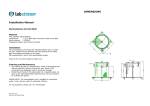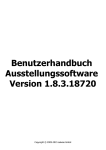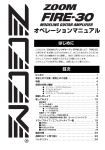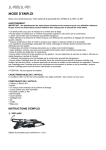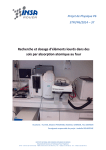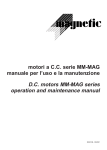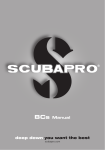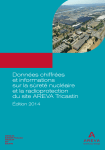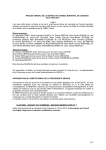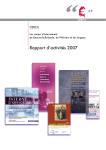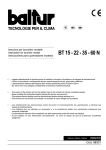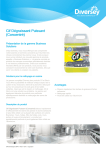Download PROLABO - CEM Service
Transcript
P 7896319 C 20418 PROLABO 54, rue Roger Salengro - BP 115 - 94126 FONTENAY-SOUS-BOIS CEDEX ASPIVAP2 NOTICE D'EMPLOI USER'S MANUEL ASPIVAP 2 (230 V) 50 Hz : 06 334 572 ASPIVAP 2 (115 V) 60 Hz : 06 334 583 ASPIVAP 2 (100 V) 50/60 Hz : 06 334 594 PROLABO, société pour la fabrication et la vente des produits et appareils de laboratoire, société anonyme au capital de 47 000 000 francs Siège social : 54, rue Roger Salengro - 94126 FONTENAY-SOUS-BOIS CEDEX - Téléphone : 01 45 14 85 00 - Fax : 01 45 14 85 15 R.C.S. Créteil B 542 081 419 - SIRET 542 081 419 00088 - APE 741 J - I.N.S.E.E. 350 75 111 0002 - N° Ident. Europe FR 81 542 081 419 DECLARATION DE CONFORMITE / STATEMENT OF CONFORMITY Suivant la directive 89/336/CEE et la directive 73/23CEE, modifiée par la directive 93/68/CEE. (According to the directive 89/336 EEC and to the directive 73/23 EEC, modified by the directive 93/68 EEC). Patrick JACQUAULT, représentant légal de PROLABO (fabricant). Patrick JACQUAULT, legal representative of PROLABO (manufacturer). Adresse : 2 route d’Ousson B.P. 26, 45250 BRIARE FRANCE. (Adress) DECLARE / STATES, que l’appareil (That the device) (Type) Type (Voltage) Tension (Frequency) Fréquence (Power) Puissance :...................................................ASPIVAP :................................................... 2 :...................................................230V, 115V, 100V :...................................................50/60Hz :...................................................210 W a été conçu, fabriqué et commercialisé en conformité avec les normes harmonisées : (Has been designed, manufactured and marketed in compliance with the harmonized norms) – EN 55022 classe B Ed.87, – EN 55104 Catégorie 1 Edition 95. – Décret 95-1081 du 03.10.95, – EN 61-010-1 paragraphes 5 et 6. suivant les recommandations de la directive : (According to the recommandations of the directive) Compatibilité Electro -Magnétique (CEM) 89/336/CEE. (Electromagnetic Compatibility (EMC) 89/336/EEC) Directive Basse Tension (DBT) 73/23/CEE. (Low Voltage Directive (LVD) 73/23/EEC). BRIARE, le :................................................... 15/05/1997 (Date and place) PROLABO (manufacturer) Patrick JACQUAULT (signer) 2 P78963.19 3 P78963.19 FCC REGULATIONS / REGLEMENTATION FCC Potential for Radio / Television Interference. (USA only) This equipment generates and uses radio frequency energy and if not installed and used properly, that is, in strit accordance with the manufacturer’s instructions, may cause interference to radio and television reception. It has been type tested and found to comply with the limits for a class “ B ” computing device in accordance with the specifications in Subpart J part 15 of FCC Rules, which are designed to provide reasonable protection against such interference in a residential installation. However, there is no guarantee that interference will not occur in a particular installation. If this equipment does cause interference to radio or television reception, which can be determined by turning the equipment off and on, the user is encouraged to try to correct the interference by one or more of the following measures : – Reorient the receiving antenna. – Relocate the terminal with respect to the receiver. – Move the terminal away from the receiver. – Plug the terminal into a different outlet so that terminal and receiver are on different branch circuits. If necessary, the user should consult the Prolabo dealer for additional suggestions. The user may find the following booklet prepared by the Federal Communication Commission helpful : “ How to Identify and Resolve Radio/TV Interference Problems ”. This booklet is available from the U.S. Governement Printing Office, Washington, D.C. 20 402, Stock N° 004-000 -00345-4. Réglementation FCC. (USA seulement) Cet équipement crée, utilise et peut émettre de l’énergie de fréquence radio et peut, s’il n’est pas installé et utilisé suivant les instructions du manuel du fabricant, être la cause d’interférences avec la réception radio et télévision. Cet équipement a été testé et trouvé conforme aux limites des appareils numériques de classe B définies par l’alinéa 15 du réglement de la FCC. Ces limites ont été établies pour fournir une protection raisonnable contre les interférences nocives lors d’une installation résidensielle. Il n’est toutefois pas garanti qu’il n’y aura pas d’interférences pour une installation donnée. Si l’équipement crée des interférences nocives pour la réception radio et télévision, ce qui peut être déterminé en allumant et en éteignant l’équipement, vous êtes encouragé à essayer de corriger les interférences en prenant une ou plusieurs des mesures suivantes : – Changer l’orientation de l’antenne de réception. – Changer la position de l’équipement par rapport au récepteur. – Eloignez l’équipement du récepteur. – Branchez l’équipement à une prise différente, de manière à ce que l’équipement et le récepteur soient branchés sur des circuits d’alimentations différents. S’il le faut, consultez un représentant de Prolabo ou un technicien expérimenté en radio/télévision pour des suggestions supplémentaires. Vous pouvez trouver le livret suivant utile : “ FCC Interference Handbook, 1986 ”, disponible à l’adresse suivante : U.S. Governement Printing Office, Washington, D.C. 20 402, Stock N° 004-000-00345-4. 4 P78963.19 TABLE DES MATIERES Introduction................................................................................................................................................6 1. Caractéristiques techniques ............................................................................................................7 1.1. étendue des fournitures ............................................................................................................7 2. Description du fonctionnement ........................................................................................................8 3. Installation ..............................................................................................................................................9 3.1. branchement électrique ..............................................................................................................9 3.2. Confection d’une s olution de lavage.......................................................................................9 3.3. Indicateur coloré ...........................................................................................................................9 4. Mode d’emploi .................................................................................................................................... 10 5. Utilisations possibles ....................................................................................................................... 11 5.1. emploi avec les digesteurs micro-ondes de la gamme Prolabo.................................... 11 6. Entretien et nettoyage ...................................................................................................................... 12 5 P78963.19 AVERTISSEMENT Veuillez lire attentivement cette notice avant d'installer et d'utiliser cet appareil. En cas de non respect des instructions, vous vous exposeriez à de sérieux dangers et vous pourriez endommager l'appareil. Par la suite, nous ne pouvons que vous conseiller de consulter régulièrement cette notice. N'hésitez pas à nous contacter pour obtenir toute précision ou information complémentaire que vous jugerez utiles pour l'utilisation de l'appareil. Pour votre sécurité, respectez scrupuleusement tous les avertissements notés DANGER. Dans cette notice, Danger, Attention et Remarque ont la signification suivante : Votre sécurité personnelle est en cause et votre vie peut être en danger. Attention ! La sécurité du matériel est concernée. Remarque Une attention particulière doit être apportée pour garantir un fonctionnement satisfaisant. 6 P78963.19 INTRODUCTION L'ASPIVAP 2 est un appareil essentiel au maintien de la qualité de l'atmosphère dans les hottes d'attaque de votre laboratoire. Les différents domaines qui le caractérisent sont les suivants : a) Respect de l’environnement . Lave et neutralise écologiquement les gaz de réactions chimiques si nécessaire, . Diminue, de manière significative, les rejets dans l'atmosphère des hottes et ralentit ainsi leur corrosion. b) Efficacité . Remplace avantageusement la trompe à eau. Son débit d'aspiration est réglable . Ne consomme pas d'eau (rentabilité assurée) . Lave et neutralise tous les types de vapeurs acides ou basiques . L'efficacité de lavage est de 95% . c) Sécurité . Le capotage complet de l'appareil protège l'utilisateur des réactifs de neutralisation . La face avant, transparente, permet de surveiller facilement le niveau des réactifs ainsi que leur efficacité d) Ergonomie . L’accès aux flacons de lavage et de neutralisation est rendue particulièrement facile par l’amovibilité du capot et la simplicité des différentes connexions . Sa pompe tout PTFE ainsi que son capotage PVC en font un appareil peu sujet à la corrosion et d'entretien limité 7 P78963.19 1 - CARACTERISTIQUES TECHNIQUES Tension de raccordement : 230 V 50 Hz 115 V 60 Hz 100 V 50/60 Hz Volume utile des vases de lavage : 1 l Puissance d'aspiration de la pompe (à vide, air 20°C) : 56 l/min Dimensions en mm : 565 x 310 x H 320 Poids en fonctionnement : 20 Kg 1.1 Etendue des fournitures L'aspirateur laveur de fumées ASPIVAP 2 est constitué de : .Un socle en PVC incluant une pompe et une vanne de réglage .Un couvercle PVC amovible .Deux flacons laveurs avec leurs bouchons et leurs tubes plongeant droit .Deux flacons dévésiculeurs avec leurs bouchons et leurs systèmes de séparation gaz/liquide .Un flacon de neutralisation avec son bouchon et son diffuseur .Trois tuyaux de connexion en Viton de couleur noire avec raccords rapides .Trois connexions rigides PVC avec raccords rapides .Une notice d'emploi Français/Anglais .Une notice de pièces de rechange Français/Anglais .Un cordon secteur 8 P78963.19 2 - DESCRIPTION DU F ONCTIONNEMENT Les gaz engendrés par la réaction sont aspirés par la pompe au travers des deux flacons laveurs contenant de l'eau (rep 1et rep 4). Une partie des gaz aspirés y sera condensée. Après ces deux flacons, les gaz traversent un flacon de séparation gaz/liquide (rep 2) avant d'être rejetés par la pompe dans le flacon de neutralisation (rep 3) au travers d'un diffuseur. Les vapeurs acides sont alors une nouvelle fois lavées et neutralisées. Avant d'être rejetés dans l'atmosphère ces gaz traversent un dernier flacon de séparation gaz liquide (rep 2). On peut réduire le débit d'aspiration de la pompe en ouvrant la vanne de réglage (rep 5). 2 1 5 4 2 9 3 P78963.19 3 - INSTALLATION 3.1 Branchement électrique Placer l’ASPIVAP 2 à gauche du module micro -ondes Raccorder l'ASPIVAP 2 au réseau électrique à l'aide du câble d'alimentation prévu à cet effet sur l'appareil. S'assurer que la tension de raccordement concorde avec les indications de la plaque signalétique placée à l'arrière de l'appareil. 3.2 Préparation de la solution de neutralisation La solution de neutralisation pour vapeurs acides est constituée d'une solution de soude à 10%, à savoir : 100g de pastilles de soude à dissoudre dans 1 litre d'eau. Cette solution, ainsi préparée, sera versée délicatement dans le flacon de neutralisation (rep.3). Dans le cas de l'utilisation de l'acide fluorhydrique, préparer une solution d'acide borique à 5% que l'on introduira dans les flacons laveurs (rep.1 et 4 ). Pour des raisons de sécurité évidentes, durant cette opération, le manipulateur devra être muni impérativement de ses protections individuelles de sécurité ( blouse, gants, lunettes ) Il est conseillé de prendre le pH de la solution de soude régulièrement pour apprécier le pouvoir de neutralisation. Si le pH se situe entre 6 et 7, la solution de soude est à changer. 10 P78963.19 4 - MODE D’EMPLOI Le fait d'utiliser l'ASPIVAP 2 ne dispense pas de manipuler sous hotte. Pour l'utiliser correctement, procéder de la manière suivante : 1° Remplir les flacons de lavage (rep 1 et 4) avec de l'eau et le flacon de neutralisation (rep 3) avec la solution préparée comme indiqué précédemment. SECURITE NE JAMAIS METTRE DE SOLUTION NEUTRALISANTE DANS LES FLACONS DE LAVAGE (rep 1 et 4) 2° Remise à leurs places des flacons en respectant le schéma de connexion situé sur le dessus du capot. 3° S'assurer de l'étanchéité de toutes les connexions 4° Replacer le capot 5° Mettre le bouton Marche/Arrêt sur la position 1 6° Régler si nécessaire le débit d'aspiration à l'aide de la vanne (rep 5) 7° Adapter la solution de neutralisation à la nature des vapeurs aspirées (acides ou basiques) 11 P78963.19 5 - UTILISATIONS POSSIBLES 5.1. Emploi avec les digesteurs micro-ondes de la gamme Prolabo On peut utiliser l'ASPIVAP 2 avec : Un Microdigest automatique A 301 Un Maxidigest 4350 Quatre Maxidigests 350 montés en série 12 P78963.19 ENTRETIEN ET NETTOYAGE Attention ! L’AUTONOMIE DE L’ASPIVAP 2 EST DE 16H PASSE CE TEMPS D’UTILISATION TOUTES LES SOLUTIONS DOIVENT ETRE CHANGEES. Attention ! Solution de lavage (flacons rep 1 et 4) : à changer impérativement une à deux fois par semaine. Attention ! cette solution peut être soit acide soit basique, suivant l'utilisation. Il faut la neutraliser avant évacuation. Attention ! Solution de neutralisation (flacon rep 3) : à changer impérativement aussitôt que l'indicateur coloré a viré. REMARQUE : Le rejet de ces solutions doit s'effectuer conformément à la législation en vigueur dans le pays concerné. Le manipulateur devra toujours être muni de ses protections individuelles de sécurité lors de ces opérations. Les tuyaux de connexion : Les rincer à l'eau une fois par semaine. Carrosserie : y passer régulièrement une éponge humide, à l'intérieur comme à l'extérieur. Laisser tourner environ ½ heure avec la vanne en position 0 afin de sécher la pompe (une fois par semaine). Changer les joints des connexions lorsqu’ils n’assurent plus l’étanchéité ( référence SAV: 19.951.242). 13 P78963.19 REMARQUE : Ne pas mouiller la pompe et ses connexions électriques. Ne pas utiliser de solvant organique pour le nettoyage. 14 P78963.19 ASPIVAP 2 USER'S MANUAL ASPIVAP 2 (230 V) 50 Hz : 06 334 572 ASPIVAP 2 (120 V) 60 Hz : 06 334 583 ASPIVAP 2 (100 V) 50/60 Hz : 06 334 594 15 P78963.19 SUMMARY Introduction............................................................................................................................................. 17 1. Technical characteristics ................................................................................................................ 18 1.1. scope of the supplies .............................................................................................................. 18 2. Operating description ....................................................................................................................... 19 3. Installation ........................................................................................................................................... 20 3.1. electrical connection................................................................................................................. 20 3.2. preparation of a washing solution ........................................................................................ 20 3.3. color indicator............................................................................................................................. 20 4. Instructions for use ........................................................................................................................... 21 5. Possible uses ..................................................................................................................................... 22 5.1. use with microwave digesters in the Prolabo range of products ................................. 22 6. Maintenance and cleaning .............................................................................................................. 23 16 P78963.19 WARNING Please read this handbook carefully before you install and use this instrument. If these instructions are not obeyed, you may expose yourself to serious danger and you may cause damage to the instrument. Following that, we can only advise you to consult this handbook regularly. Please do not hesitate to contact us for any greater detail or for any further information you may regard as useful for the operation of the instrument. In the interests of your safety, please observe all warnings labelled as DANGER. In this handbook, the words Danger, Warning and Remark have the following meanings Your personal safety is at risk and your life may be in danger. Warning ! The safety of the equipment is involved. Remark Special attention is required in order to guarantee satisfactory operation. 17 P78963.19 INTRODUCTION The ASPIVAP 2 is an apparatus which is essential for maintaining the quality of the atmosphere in the fumes hoods in your laboratory. The various areas which characterise it are listed below : a) Respect for the environment . Ecologically washes and neutralises the chemical reaction gases, if required . Significantly reduces the wastes given off into the atmosphere via hoods, and thus slows down their corrosion. b) Efficiency . Favourably replaces the glass filter pump. Its suction rate may be adjusted . Does not use water (profitability guaranteed) . Washes and neutralises all types of acid or alkaline vapours . The washing efficiency is 95% . c) Safety . The complete-closing system of the apparatus protects the user from neutralisation reagents . The transparent front side allows the level of the reagents and their efficiency to be monitored easily d) Ergonomics . Its design is particularly well thought-out . Access to washing and neutralisation bottles is made especially easy by the removable lid and the simplicity of the various connections . Its entirely-PTFE pump, as well as its PVC closing make it an apparatus which is highlyresistant to corrosion and which requires little maintenance 18 P78963.19 1 - TECHNICAL CHARACTERISTICS Connection voltage : 230 V 50 Hz 115 V 60 Hz 100 V 50/60 Hz Efficient volume for washing vessels: 1 l Suction power of the pump ( empty, air 20°C): 56 l/min. Size in mm: 565 x 310 x H 320 Operating weight: 20 Kg. 1.1 Scope of the supplies The ASPIVAP 2 smoke-washing aspirator is comprised of : . A base in PVC including a pump and an adjustment valve . A removable PVC lid . Two washing bottles with the their stoppers and their straight plunging tubes . Two separators with their stoppers and their gas/liquid separation systems . A neutralisation bottle with its stopper and its diffuser . Three black connecting pipes made of viton, with quick coupling . Three PVC rigid connections with quick coupling . An instruction manual in French/English . A spare parts booklet in French/English . A main cord 19 P78963.19 2 - OPERATING DESCRIPTION The gases resulting from the reaction are drawn in by the pump through two washing bottles containing water (item 1 and 4). Part of the gases drawn in will be condensed there. After these two bottles, the gases go through a gas/liquid separation bottle (item 2) before being discharged by the pump into the neutralisation bottle (item 3) through a diffuser. The acid vapours are then washed again and neutralised. Before being discharged into the atmosphere, these gases go through a final gas/liquid separation bottle (item 2). The suction flowrate of the pump can be reduced by opening the adjustment valve (item 5). 2 1 5 4 2 20 3 P78963.19 3 - INSTALLATION 3.1. Electrical connection Put the ASPIVAP 2 on the lelt of the microwave Connect the ASPIVAP 2 to the mains through means of the power supply cable provided for this purpose on the apparatus. Make sure that the connection voltage complies with the information on the identification plate on the back of the apparatus. 3.2. Preparation of a neutralising solution The neutralising solution for acids vapours is comprised of a 10% caustic soda solution (NaOH), namely : 100g of soda pellets to be dissolved in 1 litres of water. The solution prepared in this way is to be poured carefully into the neutralisation bottle (item 3) In case of using hydrofluoric acid, replace the water in the two washing bottles (item 1 and 4) by a 5% boric solution. For obvious reasons of safety, during this operation, it is imperative that the operator wear his safety equipment (overall, gloves, glasses) We adwise to check the pH of the soda solution regulary to see the power of neutralisation. If the pH is contained between 6 and 7, the soda solution must be changed. 21 P78963.19 4 - INSTRUCTIONS FOR USE The fact of using ASPIVAP 2 does not dispense with the necessity of carrying out manipulations under a hood. To use it correctly, proceed in the following way : 1° Fill the washing bottles (item 1 and 4) with water, and the neutralising bottle (item 3) with the solution prepared as indicated above. SAFETY NEVER PUT THE NEUTRALISING SOLUTION IN THE WASHING BOTTLES (item 1 and 4) 2°Put back the flacons respecting the assembly instructions situated on the top of the lid 3° Make sure that all the connections are watertight 4° Put the lid back on 5° Set the On/Off button to position 1 6° If necessary, adjust the flowrate of the suction through means of the valve (item 5) 7° Adapt the neutralising solution to the nature of aspirated vapours (acids or basics). 22 P78963.19 5 - POSSIBLE USES 5.1. Use with microwave digesters in the Prolabo range of products ASPIVAP 2 can be used with : A Microdigest A 301 A Maxidigest 4350 Four Maxidigests 350 23 P78963.19 6 - MAINTENANCE AND CLEANING Caution ! AFTER 16H OF USING ALL THE SOLUTIONS MUST BE CHANGED BECAUSE THE ASPIVAP IS NO LONGER EFFECTIVE Caution ! Washing solution (bottles, item 1 and 4) : must absolutely be changed once or twice a week. Caution ! this solution may be either acid or alkaline before use. It is necessary to neutralise it before removal. Caution ! Neutralisation solution (bottle, item 3) : must absolutely be changed as soon as the color indicator has turned. COMMENTS : The discharge of these solutions must take place in compliance with the legislation in force in the countries concerned. The operator must always wear his protection and safety equipment during these operations. The connection tubes : Rinse them in water once a week Body : wipe it regularly with a damp sponge, both inside and outside. COMMENT: Do not get the pump and its electrical connections wet. Do not use an organic solvent for cleaning. 24 P78963.19 25 P78963.19


























